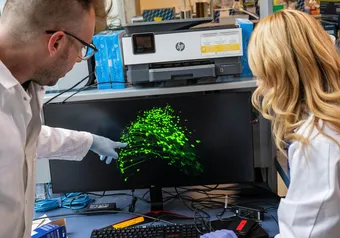It’s 6 a.m. — time to get up. Fighting the urge to go back to sleep, I drag myself out of bed. I go through my morning routine and cook some breakfast. Still groggy, I make sure to drink an extra cup of coffee. I am on-call today and I have learned that it never hurts to have that extra dash of caffeine before the start of a 24-hour shift.
Of course, I have been on-call enough times to know that there is no such thing as a “typical” shift. Some shifts can be overwhelming while others can be excruciatingly boring. Often, it is a mix of both, with no advance warning. One moment, I can be twiddling my thumbs, just waiting for something to happen and an hour later, find myself engulfed in a whirlwind of activity that doesn’t stop until the next morning. The unpredictability is what makes some students dread being on-call. While others, like me, look forward to the different challenges each shift brings.
I clean up my dishes and I am out the door soon afterwards. Usually, I aim to get to the hospital by 7 a.m. Luckily, it is a relatively short drive to the hospital. Traffic at this time of day is minimal — one of the few perks of going to work when most people are still asleep.
I arrive at the birth centre, where I am doing my six-week rotation, five minutes ahead of schedule. This particular unit consists of patients admitted by various obstetricians, family doctors as well as midwives. The obstetricians work in a call-group, meaning that everyday, there is at least one surgeon there to cover all of the high-risk pregnancies. The family doctors and midwives, on the other hand, are responsible only for their own patients. However, they often consult an obstetrician if they have concerns about the status of the mother or baby.
It is a complex system but as the medical student intern on-call, I help look after everyone — except those admitted by midwives. I begin my shift by rounding on the patients who are in active labour. This morning, there are four — although that number often changes depending on how many walk-in patients we receive throughout the day. I then check on those who had given birth last night followed by patients just awaiting discharge. I assess whether or not each patient is stable, if there are any new concerns overnight and document these findings as best as I can.
By the time I finish rounding, my attending physician — basically my boss — for the day has arrived. We quickly go over the care plan for each patient and revisit those who require special attention. This includes a first-time mother who needed a forceps-assisted delivery last night due to signs of fetal distress. Both the mother and baby are doing well. However, there is a noticeable lump on the head of the baby, where the forceps were placed. It is likely a cephalohematoma, a benign buildup of blood between the skull and the skin. But we ask the paediatrician to come and check, just in case.
After rounds, I follow my preceptor to the OR (operating room) for a pre-scheduled procedure to remove tissue samples from a post-menopausal woman with abnormal bleeding — always an ominous sign. We meet the patient in the pre-op area and go over the procedure with her again and answer some last-minute questions that she has. The anaesthetist starts to put the patient under, while my attending and I scrub-in outside the room.
We finish the case in less than an hour. The procedure itself is fairly straightforward, although the large amounts of tissue that we remove from the uterus are suggestive of endometrial cancer. We send the sample to pathology for analysis, hoping that the final outcome is better than what we expect. Though slightly disappointed about the result, I know that I have to move on. It’s a skill that almost all medical students gain early on in our training.
Once the patient regains consciousness, I go to grab a quick, overpriced lunch from the cafeteria before returning to the ward to finish some paperwork. An hour later, I receive a call from my attending. There is a pregnant patient in the emergency department who needs to be seen for severe nausea.
I arrive for the consult and encounter a young woman who is in obvious distress. She had been vomiting violently for the last two weeks and is unable to keep down any food or drink. She has been pregnant before, but her nausea has never been this bad. I jot down the history and quickly check her electronic health record to see if there is any useful information. Turns out that the patient had an ultrasound that very morning — she is pregnant with twins. The double dose of hormones released by her body caused by the twin-gestation likely explains the severity of her symptoms. My attending and I prescribe her a set of anti-nausea medications to make her feel better.
Just as we are wrapping up the consult, a page comes in from the birth centre. One of the patients is fully dilated and starting to push. I quickly run up the stairs with my attending. When we enter the room, the baby is just starting to “crown,” meaning that the fetal head has become visible. I put on sterile gloves and support the head as it came out, to prevent tearing of the mother’s perineum. Once the head is fully out, I check to make sure that there is no cord around the neck. The baby and subsequently the placenta are both delivered uneventfully. After ensuring that there are no repairs needed, I help the nurses clean up the site and congratulate the parents on their new baby.
One-by-one, all the mothers who were in labour this morning start pushing during the night. Some take longer than others. A few receive minor tears, which require suturing, but nothing too dramatic.
I finally check into the call-room upstairs around 4 a.m. Exhausted, I dive straight onto the bed, too tired to even bother taking off my scrubs. Soon, I feel the sweet relief of sleep starting to wash over me. Just then, I hear the all-too-familiar beep of my pager, pulling me back to reality.
Frustrated, I lay still for a moment. For one fleeting second, the thought of simply ignoring the page crosses my mind. But then, just as quickly, I remind myself of why I wanted to become a doctor in the first place — so that I can help others in their greatest moment of need. I reach for the phone and call the number on my pager.
A newly admitted patient is delivering another baby — sleep will have to wait. I shake the cobwebs out of my head and run downstairs as quickly as I can.
David Deng is in his third year of medical school, after completing his undergraduate degree in microbiology & immunology and psychology at UBC.
First online
Share this article








